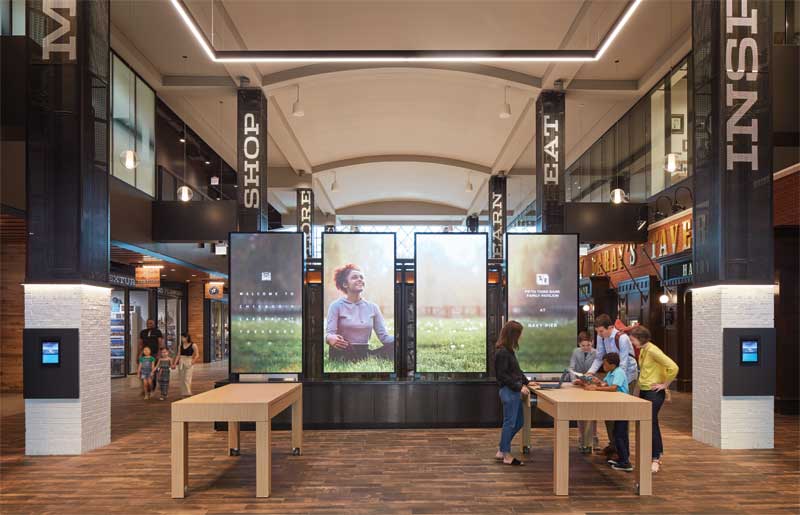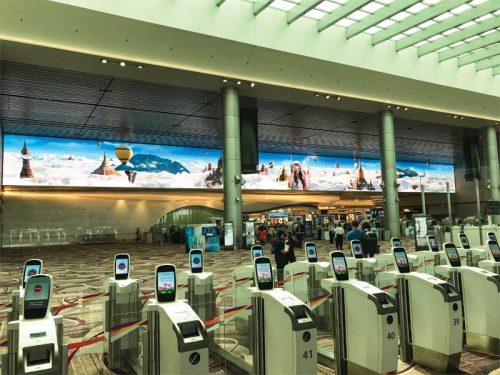How ‘servicizing’ supersizes value and accessibility
by | 11 June 2019 3:39 pm
By Joe’ Lloyd
 [1]
[1]Instead of an expensive upfront price tag, ‘servicized’ options allow customers to pay as they go with predictable monthly payments that align with the goals and limitations of their business.
Commercial digital display solutions are expensive and not every business has the capex freedom to afford the upfront costs. These price tags loom even larger when customers realize a newly purchased hardware is a depreciating asset whose lifecycle they must extend beyond the technology’s peak usefulness to protect their return on investment (ROI). Besides, most consumers are foreign to the complexity of these technologies. This unfamiliarity is a strong deterrent, especially if the business does not have the financial or human capital to invest in product trainings. Further still, display technology evolves quickly and customers are wary of buying something that may soon become obsolete, particularly when it may take a while to generate a positive return on initial costs. Together, these hurdles paint an intimidating picture for buyers who may ultimately forgo incorporating any large-scale visualization solutions despite the needs of their business and the evolving expectations of digitally reliant audiences.
The product is not the problem, the purchase is
At first, the root of this issue may appear to be the display products themselves. After all, displays are costly, confusing, and quickly outdated. The real cause of the problem is not the products, however; it is the way they are bought and sold, or rather, that they are formally bought and sold at all. In recent years, visualization experts have diagnosed that customers do not need to permanently own technology when they can temporarily control it at lower cost.
Inspired by changes in the information technology (IT) world, a few enterprising companies in the digital display industry have begun to ‘servicize’ their offerings, selling their solutions as a service rather than individual hardware units.
By selling hardware solutions as a service, manufacturers enable customers to work around the aforementioned hurdles, which often derail visualization projects. An affordable and predictable monthly payment replaces a large upfront capital expense, experts integrate management software and remain on call to provide support and training to eliminate user confusion, and timely upgrades in hardware over time ensure the technology does not become obsolete. Customers win these substantial advantages and more by acquiring visualization solutions as a service.
This article explores each advantage of visualization to give customers an understanding of where ‘servicization’ comes from, how it works, why consumers are increasingly demanding services, and why manufacturers are optimistic about its viability in the digital display industry.
The origins of servicizing
 [2]
[2]Inspired by changes in the information technology (IT) world, a few enterprising companies in the digital display industry have begun to ‘servicize’ their offerings, selling their solutions as a service rather than individual hardware units.
The concept of selling product-functions rather than product-ownership has been around for decades, but the term ‘servicizing,’ itself
rose to prominence after a paper submitted to the Environmental Protection Agency (EPA) in 1999 discussed the consequences
and responsibilities of a ‘functional economy,’ wherein the consumption of goods is replaced with the consumption of the services those goods provide.
In the paper, “Servicizing: The Quiet Transition to Extended Product Responsibility,” authors Allen L. White, Mark Stoughton, and Linda Feng discuss how manufacturers have a responsibility toward their products, especially with regard to their environmental impact. In the authors’ opinion, the longer the relationship between manufacturers and their products continues, the greater this corporate responsibility becomes. When a product is bought and sold as an isolated unit, the manufacturer’s connection to the product ends as soon as the customer’s begins. In a functional economy, where product-functions are sold as services rather than units, the relationship between the manufacturer, product, and customer overlaps and endures. This imbues manufacturers with what the authors call an ‘extended product responsibility,’ to account for their product’s externalities over time. This service-based selling approach is better for all parties, though the authors acknowledge, “to date, the servicizing phenomenon has been driven largely by business, not environmental concerns.”
It can be thought the paper was perhaps a bit too optimistic about how heavily manufacturers weighed environmental concerns when crafting their sales strategy, but it was prescient nonetheless in predicting servicizing would grow. The paper can be thought of in many ways as a roadmap for the proliferation of today’s product-function providers. In fact, the introductory summary of the paper foretells an economy where consumers pay for “mobility services rather than cars,” over a decade before the inception of today’s ride-sharing apps.
Consumers want functionality, longevity, and support, where servicizing comes in
Value is created and measured by the function provided, and for the manufacturer, the product becomes a means of delivering this function, rather than an end in itself.
Large-format digital displays have never been things to simply unbox and hang on the wall, but for decades this was how many manufacturers did business. Under that model, sale of the product was all that mattered.
Today, for consumers, this perception is finally being discarded as manufacturers acknowledge the relative value of product-function has overtaken product-ownership in the hierarchy
of consumers’ minds.
In short, servicization is a smart supplier’s answer to the changing demands of consumers, and as a strategy it cedes power to purchasers while transferring risk to the shoulders of sellers.
Consumers get the functionality they need at an affordable price, and manufacturers open their business to a larger pool of customers. This is the reason why servicization exists.
Servicizing makes visualization affordable for smaller organizations
 [3]
[3]Large-format digital displays have never been things to simply unbox and hang on the wall, but for decades this was how many manufacturers did business.
High-end display technology has typically been reserved for bigger organizations flush with cash. Sporting venues, casinos, universities, and major corporate players can afford expensive displays, while others cannot. This has left several organizations underserved by the industry and has artificially shrunk the customer pool for integrators and manufacturers. However, this no longer needs to be the case. Instead of an expensive upfront price tag, servicized options allow customers to pay as they go with predictable monthly payments that align with the goals and limitations of their business. These periodic costs are typically cheaper than competing loan options and also provide budgetary certainty, which allows customers to know exactly how much they will be spending each month.
Another benefit of servicizing visualization solutions is these products never become a financial anchor down the line. A digital display bought upfront becomes a depreciating asset immediately. Servicization saves customers from the potential pitfalls of buying a late-model display solution as a way to dodge the high costs of a brand new item.
Digital displays have become cheaper over time as manufacturing streamlines and the industry expands. Late-model displays have been attractive to budget-conscious consumers for the same reasons other older audiovisual (AV) products are: if it seems like the same product, why overpay for the newest version? This is a mistake many customers make. Each visualization upgrade contains greater functional differentiation than any of its predecessors and purchasing an older product only accelerates future concerns over obsolescence while denying audiences the visual experience one intended to give them.
Through servicization, cost-cutting customers do not need to settle for an older product. They can get the best solutions by simply paying for it as a service they subscribe to rather than a product they own outright.
Servicizing: Returning immediate ROI helps balance a budget sheet
ROI for display technologies are not positive immediately when products are purchased upfront. The price tags for large-scale visualization solutions are usually significant enough that it takes several years for customers to recoup positive value. Many digital displays are installed only for their esthetic value rather than revenue-generating potential, but this approach is typically adopted by larger organizations that can afford to do so. For smaller organizations, a digital display needs
to start providing a tangible return quickly. Servicization makes this possible. In many cases, ad space sales on a display exceed the cost of the program through which a display was acquired; this means a light-emitting diode (LED) display can become ROI positive the moment it begins operation. This makes visualization solutions a much-easier sell to organizations that might be concerned about the cost of LEDs.
Customer service is important for servicizing to work
Visualization providers that sell their products as a service are paid by unit-of-service rendered rather than unit-of-product sold. This eliminates the immediate return of an upfront payment and incentivizes sellers to nurture relationships with their customers.
This transfers risk from buyers to sellers. If a customer experiences a problem, it is in the manufacturer’s financial interest to solve it. If a customer has a question, the manufacturer’s revenues demand they provide an immediate answer. This refers to an extended product responsibility to the customer.
In this case; however, manufacturers are not tied to their products’ performance for environmental reasons, but because they have a financial imperative. If a manufacturer fails to be responsive and responsible, customers will look elsewhere.
Companies should see themselves as more than a simple display manufacturer. Customer relationships are critical and go a long way; hence transactions should not end after displays are installed, even if they are purchased as a product. Display solutions are not quick fixes; instead they are versatile, reliable answers to enduring challenges.
Since manufacturers offering servicized programs rely on positive relationships with their customers more heavily than they would if they simply sold products traditionally, giving customers the tools to operate their technology confidently is crucial. They can offer comprehensive display network management programs or softwares to relieve customers from the burden of becoming an expert on the inner machinations of their visualization solution.
Servicizing phases out obsolescence
 [4]
[4]Many digital displays are installed only for their esthetic value rather than revenue-generating potential, but this approach is typically adopted by larger organizations that can afford to do so.
As mentioned earlier, companies that have servicized their products are financially compelled to care about their customers. Over the course of these relationships, visualization products will age out of prime usefulness as superior products are invented and sold. Technological evolution is inevitable and unceasing, but companies that truly care about their customers explore avenues to safeguard older customers against future obsolescence.
Creating and delivering upgrades
Not only do manufacturers need to continue developing new technologies on their own, they need to consistently make these upgrades available to their customers. When a customer buys a display upfront, they are often stuck with the product. However, when they acquire a servicized solution, they can improve what they pay for over time.
Further, manufacturers need to design build their solutions with interchangeable subcomponents that can be swapped in and out for seamless maintenance.
Manufacturing uniform plug-and-play solutions
Ensuring continued performance from a display and avoiding obsolescence requires an understanding of how, why, and when a display might malfunction, along with built-in safeguards to quickly remedy potential issues. When the display solution is built from interchangeable and interlocking LED boards, customers can plug in a new one at any time if the old one malfunctions. This minimizes downtime and allows display owners a ready-replacement at their disposal.
While portions of an LED can be replaced, this is often not the case for liquid crystal displays (LCDs). Individual LED boards are smaller and cheaper per unit than most LCD display screens. This is why LED customers often have spares. If an LED customer orders
a replacement, they are likely to get one. Most LED manufacturers continue to make older display models as they create new ones but LCD companies may not. Uniform manufacturing standards are a less obvious factor in display servicization, but they make maintenance, repair, and upgrading more fluid over time. This wards off obsolescence and streamlines the regular enhancements a customer expects when they buy a servicized product.
Backing up everything with a warranty
A strong warranty needs to be in place to protect customers from any routine malfunctions or declines in performance. This is crucial to a future-proofed servicized solution. A warranty that covers the entire display, from corner to corner, including all parts and controller devices, effective from the date of purchase can be a game-changer for businesses. Not only will a warranty build a customer’s trust in the manufacturer but will also guarantee future business.
Joe’ Lloyd is vice-president of NanoLumens’ global marketing and business development and recent recipient of the Technology Association of Georgia’s Marketing Executive of the Year award. She is a sought-after speaker, outspoken proponent of social selling, networking, and public relations, and is dedicated to providing marketing with a strong, dependable return on investment (ROI). This article is based on a white paper she prepared for systems integrators and their end users. For more information, contact her via e-mail at jlloyd@nanolumens.com[5].
- [Image]: https://www.signmedia.ca/wp-content/uploads/2019/06/Chicago-Navy-Pier-2.jpg
- [Image]: https://www.signmedia.ca/wp-content/uploads/2019/06/RICH-TAYLOR-PHOTOGRAPHY-RTP_9914.jpg
- [Image]: https://www.signmedia.ca/wp-content/uploads/2019/06/Suria-KLCC-Mall.jpg
- [Image]: https://www.signmedia.ca/wp-content/uploads/2019/06/IMG_8291.jpg
- jlloyd@nanolumens.com: mailto:jlloyd@nanolumens.com
Source URL: https://www.signmedia.ca/how-servicizing-supersizes-value-and-accessibility/